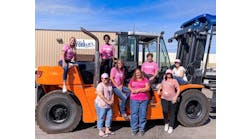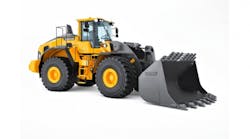The skid steer may be the most important piece of equipment of your landscape business, as well as the most frequently used. Because of their versatility, skid steers are a good investment — and can be a great investment if you take care of them. Downtime on the machines can prove to be extremely costly, so it is important to properly maintain your skid steer. If you establish a maintenance routine, you can avoid a good portion of downtime. You must perform maintenance at regular intervals. If you don't, the skid steer will suffer from excessive wear and parts that are designed to last will break quicker than expected.
Stay on Schedule
The first step in taking care of your skid steer is establishing a jobsite return process. When a machine comes back from a jobsite, give the equipment a thorough cleaning. This may uncover any obvious damage that occurred while on the jobsite or in transit. The next step involves a service schedule. All manufacturers provide a recommended service schedule, which is usually posted on the skid steer as well as in the maintenance manual. The service schedule lists items that should be checked according to hours that the machine has been used. Generally, maintenance is broken down into daily, weekly, monthly, semi-annual and annual. Daily maintenance is extremely important and is often overlooked.
Daily Duty
Operators should check the engine oil level and hydraulic/hydrostatic fluid levels before and after operation. It is important not to overfill oil and fluids. Inspect the engine air filter system for any damage or leaks. Clogged air filters and damaged air filters will cut down on horsepower and efficiency. Make sure that all sealing surfaces are free of dirt and grime. You also should check the engine coolant system for any damages or leaks. Checking the coolant system every day helps prevent overheating, lack of performance and damage to the engine. It is important to use the correct ratio of water to anti-freeze. Consult your owner's manual for the specific ratio. If the coolant level is low, add a premixed solution. Adding full strength concentrated coolant can cause early engine damage. Be careful not to overfill the coolant because it can reduce the efficiency of the cooling system and cause the machine to overheat.
Operator Protection
Almost all skid steers should have a roll over protective structure (ROPS) and falling object protective structure (FOPS). These structures are designed to keep the operator safe from tools or rocks that may fall and in the event of a rollover. You should inspect the ROPS/FOPS for dents and cracks. The operator's cab should never be modified unless instructed to do so by the manufacturer. Modifying includes but is not limited to welding, grinding, drilling holes or making additions to the cab. If there is a concern of damage, you should take the skid steer to your local dealer for inspection. The dealer will advise you if the ROPS/FOPS should be replaced. The cab mounting hardware also needs to be checked to ensure that it has not worked loose. Nuts and bolts should be looked over for excessive wear and tear. The seat belt and seat bar are necessities for the ROPS/FOPS to fully protect the operator. Make sure that the seat belt will adjust by pulling on the belt. If the belt is obstructed there may be dirt in the retractors. Simply clean out the retractors and the belt should work. If cleaning the retractors out does not work they may need to be replaced. Seat bar restraints are essential to the overall safety of the skid steer. Most skid steers have a pivoting seat bar that when set in the up position, it locks the lift and tilt functions in the neutral position on the loader. You can use compressed air to remove any dirt that is around the pivot points of the seat bar restraint. Most seat bars are not designed to be oiled. If any of the parts show wear they should be replaced as soon as possible.
Lubrication
Lifting arms, cylinders and pivot pins need to be lubricated after every use. Most manufacturers use lithium based multi-purpose grease on the lifting mechanisms. When applying grease make sure to do so until the grease shows around the fitting. Also, make sure to apply the grease to each and every fitting, there are usually several. Inspect the lift cylinders for any leaks or damage. The lift cylinders are vital to the operation of the skid steer and a faulty cylinder can cause more damage to the machine.
Getting Attached
There are several dozens of attachments that can be used with your skid steer. These attachments can save you time and money. Attachments deserve the same care that your skid steer receives and it is important to use the correct attachments for your model. Buckets and attachments are approved by rated operating capacity and for a secure fit to the front of the machine. Rated operating capacity is determined by using a standard bucket and standard material like dirt or gravel. In the case that a larger bucket is used, it causes the load center to move forward and reduces the rated operating capacity. If an extremely dense material is loaded, the volume has to be reduced to prevent overloading. By exceeding the rated operating capacity you lose the stability of the skid steer, steering the machine will become more difficult, and the productivity of the skid steer will be reduced. Overloading the machine also cuts down on the life of your machine's tires.
Rolling Along
Tires are probably the most important items to inspect on your skid steer. Your tires need to be inspected regularly for wear, damage and pressure. The tires should be inflated to the maximum pressure that is listed on the sidewall of the tire. By keeping the tires inflated at the correct pressure, you will have reduced wear and increased stability and handling capabilities. Tires need to be rotated periodically as well because the rear tires tend to wear faster than the front tires. In order to keep the wear even, just rotate the tires. Same sized tires on each side of the skid steer helps to maximize the mobility. If different sized tires are used they are going to wear at different rates causing excessive wear. Also, it is important that the tire treads face the same direction. This helps with the maneuverability of the machine. Most manufacturers request that you do not mix brands of tires on the machine. If different brands are used you will incur inconsistent wearing and are likely to experience loss of stability. Rims need to be inspected for dents, rust and scraps. If the rim is bent or has a dent it should be replaced. Dented or bent rims can cause serious tire problems.
Some lawn care professionals prefer track loaders because they require less maintenance than other equipment since there are never any flat tires to repair. The track design reduces equipment downtime caused by a flat tire and the tracks also clear themselves of debris. Abrasive materials, such as mud and sand, are shed away reducing wear on tracks and wheels. To keep track loaders performing at their best, inspect for leaks and check fluid levels before using the machine. You should also check hydraulic fittings and hoses and look at the tracks for proper tension after each job.
Long life
Your skid steer is an extremely important part of your business and maintenance on the machine should be equally important. Proper care will result in a long and productive life for your skid steer. By implementing an inspection process you will be able to catch small problems before they become large headaches. Keeping your skid steer clean also allows you to speed up the inspection process and easily identify leaks and/or damages. Routine maintenance allows your skid steer to be more productive and can make your business more efficient. Simple care for your skid steer should provide big returns on a big investment.
Tyson Holmquist is sales coordinator for United Rentals (Overland Park, Kan.).
RELIABILITY
Decreasing costly downtime is a priority for every equipment owner. While a reliable machine with high-quality hydraulic and engine components may cost more up front, the investment will eventually pay off in the money you save from costly repairs and expensive downtime. If you're considering an overseas manufacturer, make sure that the U.S. factory keeps a large stock of replacement parts here. This will significantly cut down on the time you're waiting for new parts.
Another thing to consider regarding the reliability of a machine is the terrain of your typical job site. For instance, if you do a lot of off-road construction on muddy or sandy sites, a tracked compact excavator will be the most reliable machine for your operations. However, if most of your sites require self-transporting mobility and speed on paved surfaces, you should purchase a wheeled machine to ensure that you get the most efficient usage available.
Source: “Considering Compacts,” Grounds Maintenance, November 2002, Mark Hennessey, Mustang Manufacturing Co., Inc.
RENT, THEN BUY
With so many skid-steer loaders to choose from, it is smart to evaluate as many machines as you can before making a purchase decision. Kick a few tires. You may by surprised to see how far some machines have evolved — there have been a lot of innovative changes made to skid-steer loaders in recent years.
Also, as part of your pre-purchase evaluations, consider renting a machine before buying it. With a rental, you can conduct your own field testing with the landscaping projects typical to your business. If you do rent a skid-steer loader, make certain the rental house fully briefs you on the machine's features and operating capabilities. Each manufacturer's products have some unique qualities, and you need to know them first before you operate them for the first time.
Source: “Equipment Options: Skid-steer loaders,” Grounds Maintenance, November 2001, Doug A. Johnson, Caterpillar Inc.


